Page Contents
- 1 OVERVIEW
- 2 SUTURE WITH THE NEEDLE ATTACHED: CORE COMPONENTS
- 3 COMPONENT 1: NUMBER OF SUTURE CONSTRUCTION
- 4 COMPONENT 2: SUTURE MATERIAL
- 5 COMPONENT 3: SUTURE SIZE (USP MEASUREMENT)
- 6 COMPONENT 4: SUTURE SIZE (METRIC MEASUREMENT)
- 7 COMPONENT 5: SUTURE LENGTH
- 8 COMPONENT 6: SUTURE COLOR
- 9 COMPONENT 7: NEEDLE NAME
- 10 COMPONENT 8: NEEDLE TYPE
- 11 COMPONENT 9: NEEDLE SILHOUETTE
- 12 COMPONENT 10: NEEDLE CURVATURE
- 13 COMPONENT 11: NEEDLE POINT SHAPE
- 14 COMPONENT 12: NEEDLE LENGTH
OVERVIEW
There are many different types of suture available for use in a surgical/procedural setting, and there are also many different preferences on what type of suture to use when. This page aims to serve as a guide to the different suture types with the hope that trainees will not be as overwhelmed by the options available.
SUTURE WITH THE NEEDLE ATTACHED: CORE COMPONENTS
Suture is available with or without a needle attached. Because the needle itself brings some nuance, we will start by breaking down all the different core components of a suture that has a needle attached to it. Let us refer to the image below:
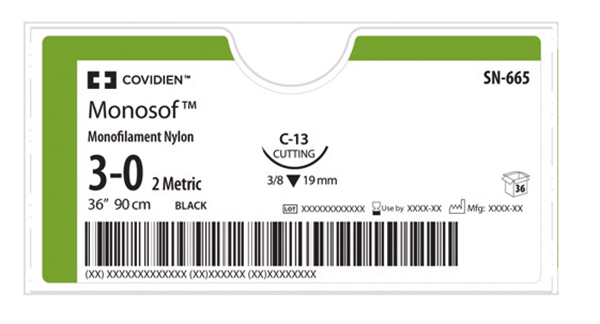
This packaging is covered with a significant amount of information that can be difficult to decipher. For this reason the same image has been annotated and each component of the packaging will be discussed more in depth below.
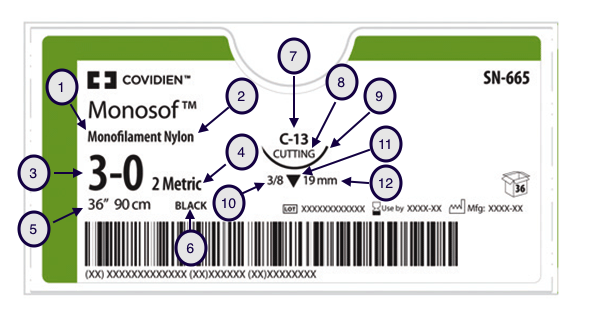
COMPONENT 1: NUMBER OF SUTURE CONSTRUCTION
Looking at the suturing packaging above, one of the first pieces of information given is that it is a monofilament suture. This means that there is only one strand of suture as opposed to a braided suture which has been created by literally braiding multiple filaments together. Let us expand a bit more on the differences of various suture construction types:
Monofilament sutures:
Braided sutures:
COMPONENT 2: SUTURE MATERIAL
The next piece of information revealed is what material the suture itself is made from. This particular suture is made from nylon, however there are multiple options. Below some of them are elaborated upon.
Nylon:
Silk:
COMPONENT 3: SUTURE SIZE (USP MEASUREMENT)
Suture sizes are defined by the United States Pharmacopeia (USP) which represents the DIAMETER of the suture. This particular package of suture is sized 4-0 however many sizes are available. The sizing is slightly confusing however is explained below:
Sizes 11-0 to 1-0
The smallest suture available is the 11-0. As the numbers decreases (up until 1-0) the diameter of the suture increases as well. The larger the number the smaller the diameter of the suture.
Size 0
Size 0 suture falls between two opposing styles of suture USP naming nomenclature. It is larger then all of the USP measurements in the #-0 format (above) but smaller then all the sutures in the # format (below)
Sizes 1-5
Sutures classified in this sizing nomenclature follow an opposite pattern (compared to sizes 11-0 to 1-0). The larger the number the larger the diameter of the suture.
COMPONENT 4: SUTURE SIZE (METRIC MEASUREMENT)
To make things more nuanced, the size of the suture not only has a USP classification, but also a metric corollary that more objectively states the diameter of the suture in millimeters (for example the suture above is 2 Metric which corresponds to 0.2 mm in diameter).
Things are made slightly more confusing by the fact that the USP measurements equate to different metric measurements depending upon if the suture material is collagen based or synthetic. The table below aims to clarify the size conversions:
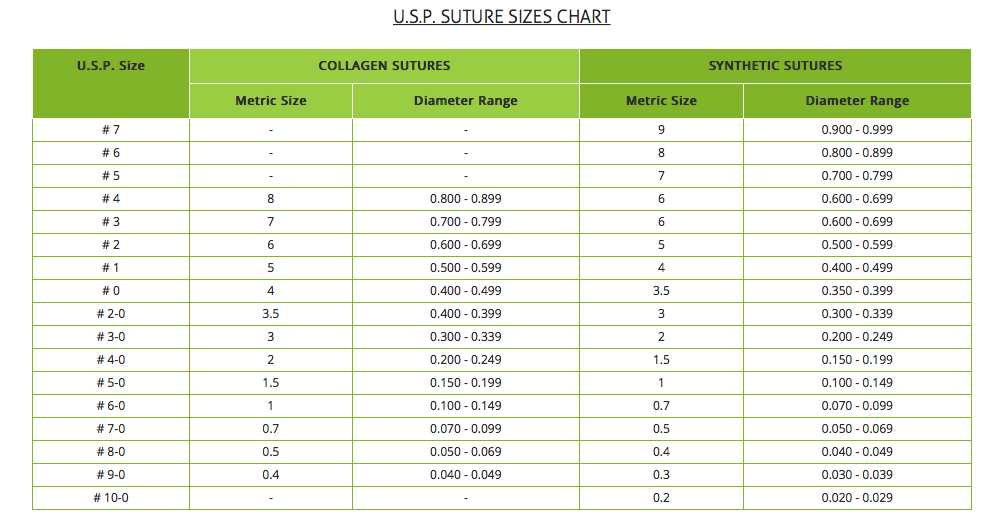
COMPONENT 5: SUTURE LENGTH
This one is an easy one. It corresponds to how long the suture thread is. It is listed both in both inches and centimeters.
COMPONENT 6: SUTURE COLOR
Another simple component. This explains the color of the suture. Depending on the task the color of the suture may be important.
COMPONENT 7: NEEDLE NAME
The needle name refers to a shorthand “code” that summarizes what type of needle is attached to the suture. It varies depending upon the manufacturer and there are MANY needle names out there. This particular needle is made by the company Covidien and is referred to as a C-13 needle. The image below shows what type of needle it is and the name used by other brands.
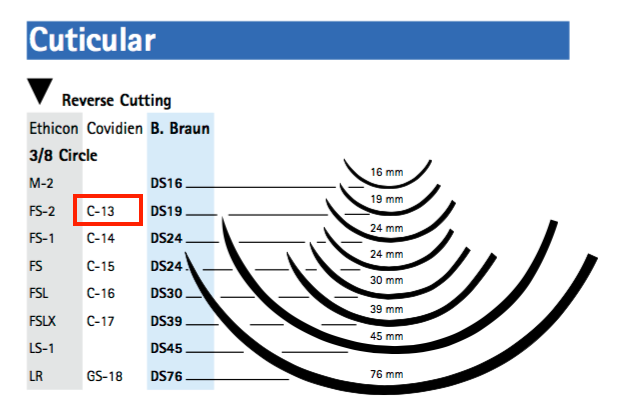
While only a few numbers/letters, the needle name carries a lot of information! Components 8-12 help to highlight the information that relates to this needle name.
COMPONENT 8: NEEDLE TYPE
There are a few different types of needles that sometimes are listed on the packaging. In this example the C-13 needle is a “reverse cutting” needle (even though this component only shows the label “cutting”. Below some of the different types of needles are explained.
Reverse cutting needles:
Tapered needles:
COMPONENT 9: NEEDLE SILHOUETTE
The needle silhouette demonstrates a life sized (it is to scale) profile of the needle. It helps communicate the shape, length, and thickness of the needle.
COMPONENT 10: NEEDLE CURVATURE
There are many different types of curvatures that are present on suturing needles. This needle has “3/8” listed on the package which refers to a “3/8 circle” needle. This literally explains that the needle is shaped such that it is “three eights” of a perfect circle. The picture below better depicts the curvature of different types of needles.
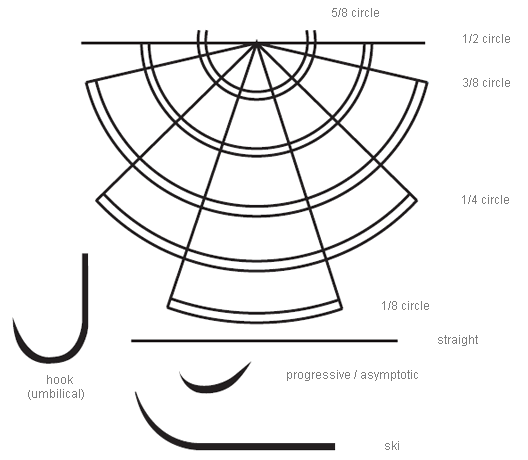
COMPONENT 11: NEEDLE POINT SHAPE
Typically on packages, a symbol is provided that shows a cross section of the needle tip. This particular suture demonstrates a black inverted triangle that represents a reverse cutting needle. The table below demonstrates a few examples of needle points/their respective symbols.
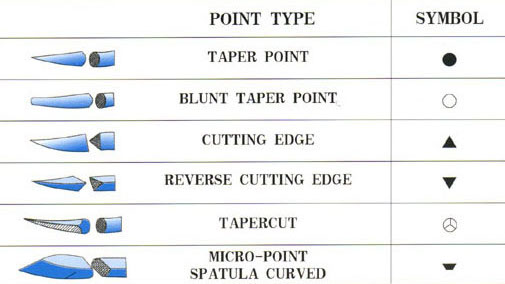
COMPONENT 12: NEEDLE LENGTH
This last piece of information shows how long the suture needle is (in millimeters). In this example the needle is 19 mm long.
Page Updated: 06.29.2017